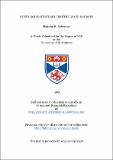Files in this item
Novel solid-state millimetre-wave sources
Item metadata
| dc.contributor.advisor | Lesurf, J. C. G. | |
| dc.contributor.author | Robertson, Malcolm R. | |
| dc.coverage.spatial | 187 p. | en_US |
| dc.date.accessioned | 2018-07-06T09:16:05Z | |
| dc.date.available | 2018-07-06T09:16:05Z | |
| dc.date.issued | 1993-07 | |
| dc.identifier.uri | https://hdl.handle.net/10023/15038 | |
| dc.description.abstract | A study of some principal solid-state millimetre-wave sources was carried out, using mainly quasi-optical techniques developed at St. Andrews. A review of the theory of operation of Gunn oscillators was undertaken, and a number of wideband tunable Gunn oscillators were built, incorporating Gunn diodes from several different manufacturers. Characterisation of their frequency range, power output, bias tuning, and frequency stability were measured. Effects such as bias oscillations and frequency jumps were also noted, and the iterative techniques required to build an oscillator to a certain specification were presented. Frequency multipliers are widely used to extend the frequency range of solid-state oscillators, and the techniques used to design frequency multipliers were studied. The use of non-linear capacitors (varactor diodes), and non-linear resistors (varistors and resonant-tunneling diodes) was considered in some detail. An experimental doubler block was designed and built, and doubling using both varactors and varistors was measured and evaluated. A number of resonant-tunneling double-barrier diodes, or quantum-well devices, was made available through collaboration with Nottingham University. The tunneling process in these devices is inherently fast, making these devices suitable for high-frequency operation as detectors, oscillators, multipliers and mixers. The theory of operation of double-barrier diodes was studied, and methods of evaluating their maximum oscillation frequency were compared. Several different devices were mounted in a whisker-contacted waveguide circuit, and oscillations at W-band were measured. A whisker-contacted multiplier block was designed and built, and zero-bias tripling to 254GHz was observed. Resonant-tunneling diodes were also shown to be capable of acting as self-oscillating mixers at W-band. Effects such as injection locking and chaotic oscillations were measured. A new class of noise source, the chaotic or semi-chaotic noise source, was considered as a future device. Its potential applications, and its advantages over conventional noise sources, was discussed. | en_US |
| dc.language.iso | en | en_US |
| dc.publisher | University of St Andrews | |
| dc.subject.lcc | TK7872.W2R7 | |
| dc.subject.lcsh | Ocillators | |
| dc.title | Novel solid-state millimetre-wave sources | en_US |
| dc.type | Thesis | en_US |
| dc.type.qualificationlevel | Doctoral | en_US |
| dc.type.qualificationname | PhD Doctor of Philosophy | en_US |
| dc.publisher.institution | The University of St Andrews | en_US |
This item appears in the following Collection(s)
Items in the St Andrews Research Repository are protected by copyright, with all rights reserved, unless otherwise indicated.

